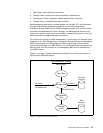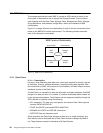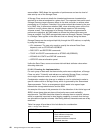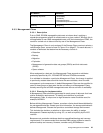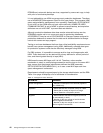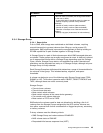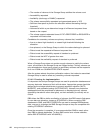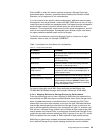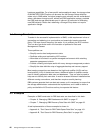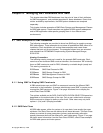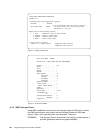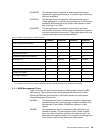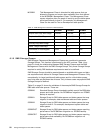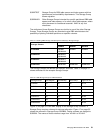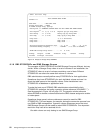
Storage Management with DFSMS 45
Electing DB2 to select the volume requires assigning a Storage Class with
guaranteed space. However, guaranteed space reduces the benefits of SMS
allocation, so this approach is not recommended.
If you do choose to use specific volume assignments, additional manual space
management must be performed . Unlike non-SMS, SMS does not retry to skip a
volume that cannot satisfy the requested space. Free space must be managed for
each individual volume to prevent failures during the initial allocation and
extension. This will generally require more time for space management, and will
result in more space shortages. Guaranteed space should only be used where
the space needs are relatively small and do not change.
To identify and reference a particular Storage Group, a unique one to eight
character name is used, for example, SGDBFAST.
Table 11 provides a list of attributes for consideration.
Table 11. Storage Group Attributes
For further information on all SMS Class attributes and definitions, see
DFSMS/MVS DFSMSdfp Storage Administration Reference, SC26-4920.
5.3.4.3 Mapping Devices to Storage Groups for Performance
From the performance point of view, migrating to SMS offers the opportunity to
automatically set DB2 allocations to predefined disk areas. Each storage server
offers a predetermined level of parallel access. For example, the RVA Turbo
allows eight concurrent data transfers to and from the host. DB2 administrators
and storage administrators can distribute the Storage Groups to maximize the
use of parallel capability offered by each storage server type. For example, with
RVA servers, a Storage Group should have a multiple of eight volumes per RVA
and be spread over several RVAs. A performance oriented small Storage Group
could have just eight volumes defined per RVA (in groups of two by LCU, and by
RVA) and spread over the number of RVAs required for best parallel access.
SMS offers a performance oriented automated allocation mechanism provided
that a defined Storage Group logical topology matches the current installed
ATTRIBUTE COMMENT
Auto Migrate Specifies whether migration should be permitted on
this Storage Group.
Auto Backup Specifies whether backup should be performed on
this Storage Group.
Auto Dump Specifies whether full volume dumping should be
performed on this Storage Group.
Migration Threshold
(High and low)
A percentage figure which when exceeded forces
migration to occur. Likewise, a percentage figure, at
which migration stops.
Dump Classes Specifies the frequency of auto dumping, if required.
Guaranteed Backup Frequency Specifies the maximum number of days that can
elapse between backups. NOLIMIT indicates data
sets in the Storage Group are backed up according
to their Management Class.



